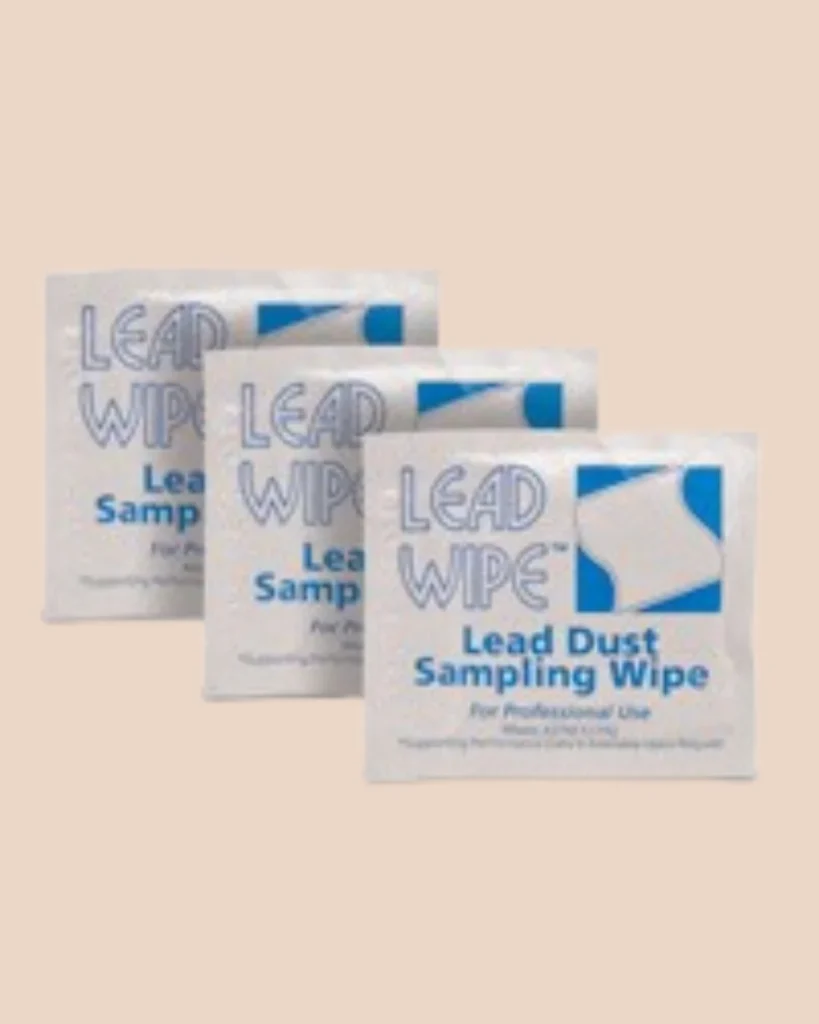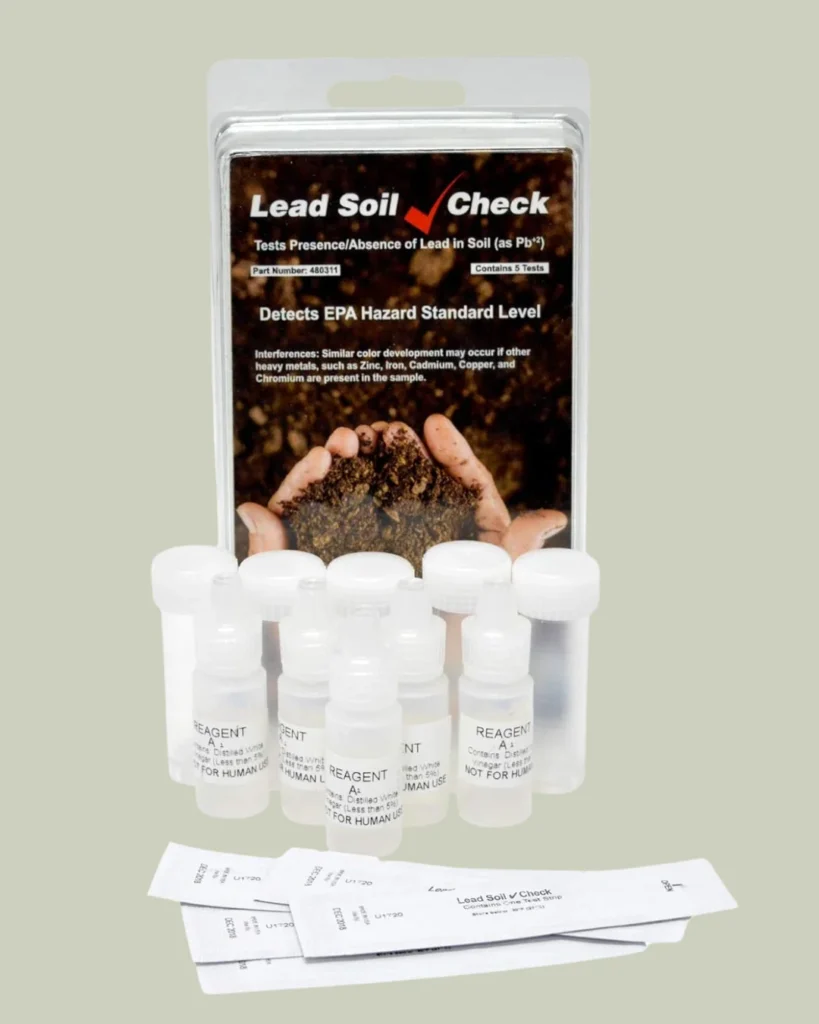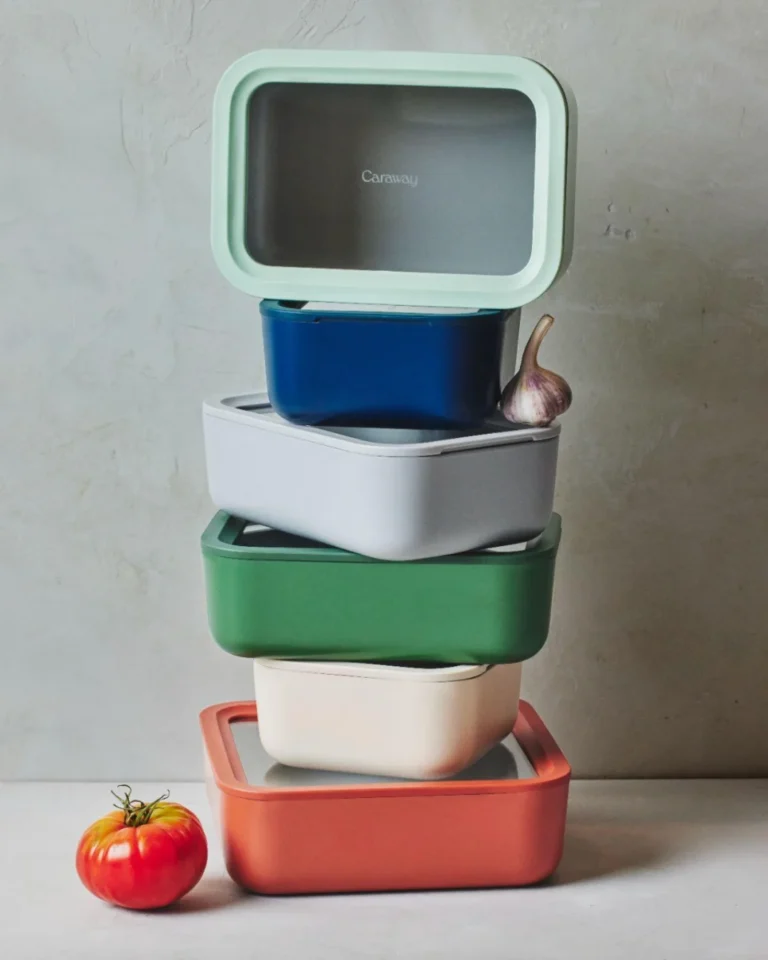SKL is reader supported. When you buy through links on our site, we may earn affiliate commission. Learn more here.
I’ve read countless studies about the dangers of lead poisoning, and the potential harm it can cause is downright alarming—everything from developmental delays in children to severe health issues in pets.
It’s terrifying to think that something as innocuous as an old toy or a vintage ceramic dish could pose such a risk. But not to worry, the SKL team has created this epic guide to help you put fear to the side and allow empowerment take front and center stage.
This guide will walk you through exactly how to test for lead exposure at home, what to do if you found lead in your home, and how to steer clear of lead in the future.
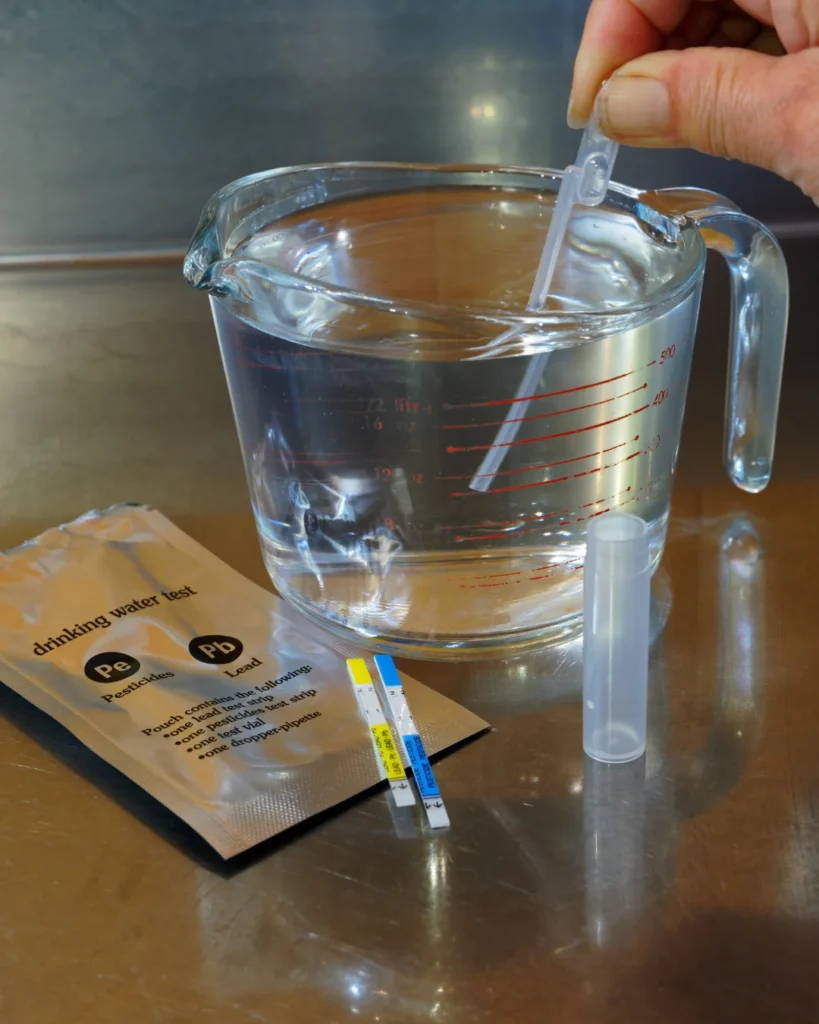
Your Full Guide to Testing for Lead Exposure at Home
Have you ever wondered if that vintage teapot you snagged at the flea market is more than just a charming addition to your kitchen? Or maybe you’ve questioned whether those hand-me-down toys are safe for your little ones. Unfortunately, lead presence is way more common than you think.
Stanley Cup is facing a lawsuit over using lead in its manufacturing. Dozens of Dollar Store products commonly test positive for toxic chemicals.
Cheap, costume jewelry from stores such as Claire’s and Target was found to have high levels of lead and cadmium.
Shein clothes contain chemicals in amounts 20 times higher than the safe limit. Non-organic tampons were found to contain toxic metals like lead, arsenic, and cadmium.
The takeaway? Lead is sneaky. This heavy metal can be found in old paint, plumbing pipes, ceramics, and even some cosmetics.
Once it’s in your system, it can cause serious health issues. As always, knowledge is power, and knowing how to test for lead can keep you and your family healthy.
While nothing beats the accuracy of professional testing, at-home lead tests can give you a sneak peek into what’s lurking in our homes and how serious the situation might be.
They’re convenient, budget-friendly, and a great first step to figuring out if we need to call in the big guns.
What is Lead?
Lead is a naturally occurring heavy metal found in the Earth’s crust. It’s a bluish-gray metal that’s soft and malleable, making it a favorite for many industrial uses.
Lead has been used by humans for thousands of years. The Romans, for example, were quite fond of lead for their plumbing and even added it to their wine to sweeten the flavor (yikes!).
Fast forward to the 20th century, and lead was making its way into paint, gasoline, and a variety of household products.
It wasn’t until the late 20th century that we started to fully understand just how toxic lead is, leading to stricter regulations and a phase-out of its use in many products.
Despite these efforts, the legacy of lead lingers in our environment, particularly in older homes and urban areas.
How Lead Enters The Body?
There are three main ways: inhalation, ingestion, and dermal contact.
- Inhalation: Imagine tiny lead particles floating in the air like invisible dust. When we breathe in these particles, they can travel deep into our lungs and enter our bloodstream. This is a common risk in environments where lead-based paint is deteriorating or during renovations that disturb lead-containing materials.
- Ingestion: Have you ever heard of the phrase “don’t eat paint chips”? It’s good advice! Lead can enter the body when we accidentally ingest contaminated dust, soil, or paint chips. This is particularly concerning for young children who might put their hands or other objects in their mouths after they’ve touched lead-contaminated surfaces.
- Dermal Contact: While not as common, lead can also be absorbed through the skin, especially if you’re handling lead-containing products without proper protection. This is a bigger concern for workers in industries that use lead, but it’s still something to be aware of at home.
How Lead Affects the Health of Children
Lead exposure is no joke! Children are particularly vulnerable to lead poisoning, and it’s not just because they tend to put everything in their mouths. Their bodies are still developing, making them more susceptible to the toxic effects of lead.
Lead exposure in children can be devastating for brain development. According to the CDC, even low levels of lead in the blood can affect a child’s IQ, ability to pay attention and academic achievement.
A study published in the New England Journal of Medicine found that children with blood lead levels as low as 5 micrograms per deciliter can experience significant cognitive deficits.
Lead exposure has also been linked to behavioral problems in children. The National Institute of Environmental Health Sciences (NIEHS) reports that children exposed to lead are more likely to exhibit hyperactivity, aggression, and difficulty with impulse control.
What’s more, lead doesn’t just mess with the brain; it can also affect a child’s physical growth. The World Health Organization (WHO) states that lead can interfere with the development of bones and teeth, and in severe cases, it can lead to stunted growth and delayed puberty.
How Lead Affects the Health of Adults
Adults aren’t immune to the dangers of lead, though the symptoms might be sneakier and often go unnoticed until significant damage has been done.
Lead exposure in adults has been linked to high blood pressure and heart disease. The National Institute for Occupational Safety and Health (NIOSH) found that lead can increase blood pressure by damaging the walls of blood vessels and causing them to constrict.
Your kidneys act like a filtration system for your blood, and lead can gum up the works.
Long-term exposure to lead can cause chronic kidney disease, as noted in a study by the Journal of the American Society of Nephrology.
On top of that, lead can severely affect our reproductive health. In men, lead exposure can reduce sperm count and motility, while in women, it can cause menstrual irregularities and complications during pregnancy.
Also, I recently came across a study in Environmental Health Perspectives that points out how lead can cross the placental barrier, putting unborn babies at risk.
Additionally, just like in children, lead can mess with adult brains too. Adults exposed to high levels of lead may experience memory loss, difficulties with concentration, and even mood disorders such as depression and anxiety.
The American Journal of Epidemiology explains that chronic lead exposure is associated with an increased risk of neurodegenerative diseases like Alzheimer’s.
The Most Common Sources of Lead Exposure
1. Old Paint
If your home was built before 1978, there’s a good chance it has layers of lead-based paint. Back in the day, lead paint was all the rage for its durability and vibrant color. However, as it ages, this paint can chip, peel, and turn into hazardous dust.
How to Avoid It:
- Have your home inspected by a certified lead inspector to identify areas with lead paint. The Environmental Protection Agency (EPA) provides a list of certified professionals.
- Regularly check and maintain painted surfaces to prevent peeling and chipping. If you see any damaged paint, address it immediately.
- If renovating, use contractors certified in lead-safe practices to contain and clean up any lead dust. This means sealing off areas, using HEPA vacuums, and properly disposing of lead-contaminated debris.
- Choose non-toxic paint for walls, wood, and metal that’s odor-free, safe, and ideal for spaces frequented by children and pets.
2. Water Pipes & Fixtures
Lead can leach into drinking water through old lead pipes, solder, and plumbing fixtures. This is particularly a concern in homes built before the 1980s, as lead was commonly used in plumbing.
How to Avoid It:
- Test your water for lead using a home testing kit or by contacting your local water authority. The EPA recommends testing tap water annually.
- Use a PFAS water filter certified to remove lead (look for NSF/ANSI Standard 53). Be sure to maintain and replace filters according to the manufacturer’s instructions.
- Consider replacing old lead pipes and plumbing fixtures with safer alternatives. This can be costly, but some local programs may offer assistance or subsidies.
3. Contaminated Soil
Lead can linger in soil, especially near older homes with lead paint or in areas previously used for industrial activities. Kids playing outside can easily come into contact with contaminated soil and bring it indoors.
How to Avoid It:
- Test your soil for lead, particularly in play areas and gardens. You can purchase soil testing kits or contact local health departments for recommendations.
- Cover bare soil with grass, mulch, or other ground covers to reduce direct contact. This also helps prevent the soil from being tracked indoors.
- Use raised garden beds filled with clean soil for growing vegetables to minimize the risk of lead contamination in your produce.
4. Children’s Toys & Jewelry
Some imported toys and jewelry have been found to contain high levels of lead. Young children often put these items in their mouths, leading to the ingestion of lead.
Some manufacturers use lead in plastics to make them more flexible and durable. Lead is cheaper than safer alternatives. Manufacturers looking to cut costs might use lead, particularly in inexpensive, mass-produced items.
How to Avoid It:
- Check for product recalls and safety warnings on the Consumer Product Safety Commission (CPSC) website.
- Be cautious with cheap, imported toys, especially from street vendors or unknown sources.
- Choose natural wooden baby toys from eco-friendly toy brands.
- Make sure that your jewels come from certified sustainable & ethical jewelry brands with reputable certifications to prove their toxic-free claims.
- Use home lead test kits to check suspect items. These kits are available at most hardware stores and can give you peace of mind.
5. Lead-Glazed Ceramic Ware & Pottery
Lead-glazed ceramic ware and pottery are toxic because lead from the glaze can leach into food and beverages, especially when the pottery is improperly fired or used with acidic foods and liquids.
Despite its toxicity, lead is used in ceramic glazes because it helps achieve a smooth, glassy finish that enhances the appearance and durability of the ware. It also lowers the melting point of the glaze, making the production process more efficient and affordable.
However, the beautiful sheen and vibrant colors achieved through lead glazes come at the cost of potential lead exposure, which is why it is crucial to be cautious with older or imported ceramic items that might not meet current safety standards.
How to Avoid It:
- Avoid using lead-glazed ceramics and pottery for food storage, preparation, or serving. You can reserve them for decorative purposes only.
- If you love ceramics, opt for certified non-toxic dinnerware and cookware choices.
Lead Poisoning Symptoms in Kids
Developmental Delay: One of the most alarming effects of lead exposure in children is developmental delay. Lead interferes with the normal development of a child’s brain and nervous system, which can lead to delays in reaching milestones such as talking, walking, and other cognitive functions. It’s like having a roadblock on the path to your child’s growth, making it harder for them to catch up with their peers.
Learning Difficulties: Children exposed to lead often struggle in school. Lead affects the areas of the brain involved in learning and memory, leading to difficulties with reading, math, and other academic skills.
Irritability: Kids with lead poisoning can become unusually irritable and fussy. The irritability is not just a typical childhood mood swing but a result of the toxic effects of lead on their developing nervous system. Imagine dealing with a constant tantrum that seems to have no clear cause—it’s frustrating for both the child and the parents.
Weight Loss: Lead exposure can lead to a lack of appetite and subsequent weight loss. This isn’t just about picky eating; it’s a more insidious effect where the child’s overall health and energy levels start to dwindle. A child who once had a healthy appetite might suddenly seem uninterested in food, leading to weight loss.
Lead Poisoning Symptoms in Adults
High Blood Pressure: In adults, one of the most common symptoms of lead poisoning is high blood pressure. Lead exposure can damage the cardiovascular system, leading to increased blood pressure and a higher risk of heart disease.
Joint and Muscle Pain: Lead can cause significant pain in the joints and muscles, making everyday activities uncomfortable. This pain is often mistaken for arthritis or other common conditions, but its cause is the toxic buildup of lead in the body. Imagine feeling like you’ve aged decades overnight—your joints creak, and your muscles ache without any clear reason.
Difficulties with Memory or Concentration: Just as in children, lead affects brain function in adults, leading to difficulties with memory and concentration. This can manifest as forgetfulness, trouble focusing on tasks, or even confusion. It’s like having a cloud over your thoughts, making it hard to think clearly or stay on track.
Headache: Persistent headaches are another symptom of lead poisoning in adults. These headaches can be debilitating, affecting your ability to work, relax, and enjoy life, and are often resistant to typical over-the-counter remedies.
Encephalopathy, Seizures, and Coma: In the most severe cases, lead poisoning can lead to encephalopathy, a serious brain condition that causes symptoms such as confusion, drowsiness, and seizures. If not treated promptly, this can progress to coma and even death. Encephalopathy is the body’s way of sounding a loud alarm—an urgent, life-threatening condition that requires immediate medical intervention.
How to Test for Lead Exposure At Home
1. Home Lead Test Kits
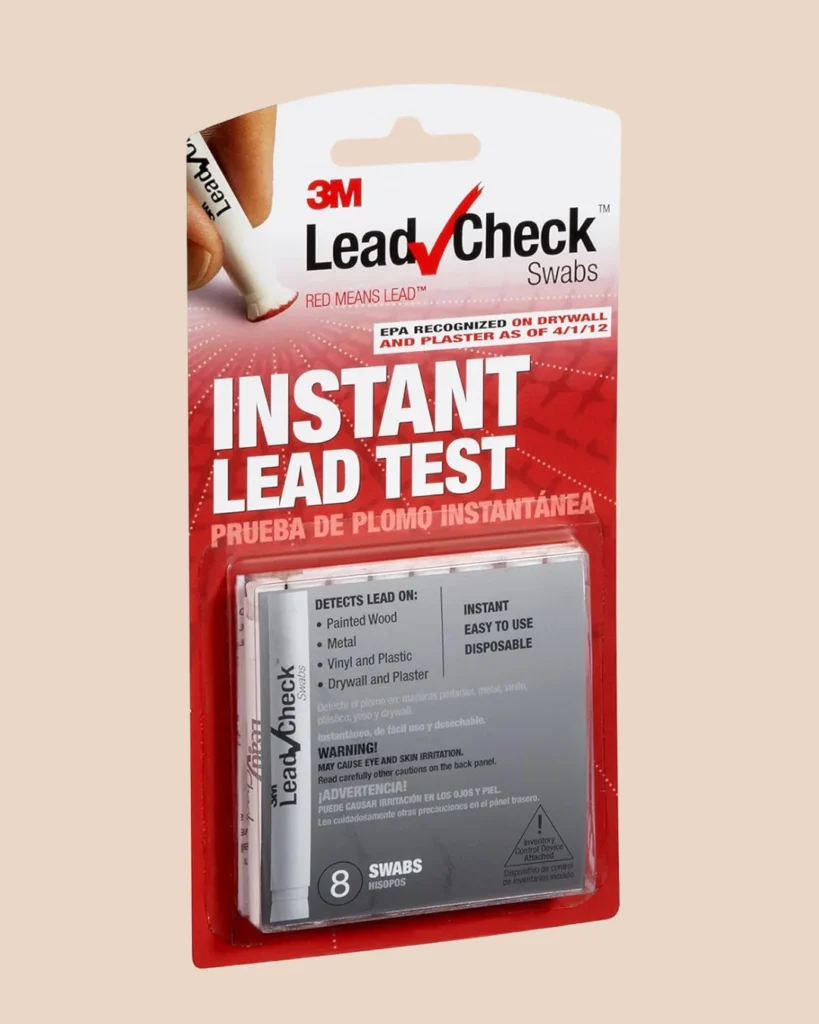
Home lead test kits are an easy and relatively inexpensive way to check for lead in your home. These kits come equipped with swabs that change color if lead is present. They can be used on a variety of surfaces, including paint, dust, soil, and even toys.
While there are many kits available online, it would be best to go with EPA-recognized options such as the D-Lead® Lead Paint Test Kit.
It can detect the presence of lead and lead chromate coatings on structural steel, aluminum, concrete, brick, stucco, sidings, water towers, ships, docks & shipyards, and gas storage tanks.
If you want to test virtually every surface for lead dust, the LeadCheck Swabs test is a great option. It’s EPA-recognized and can test for lead on surfaces such as painted surfaces, steel structures, vinyl, and other plastics.
How to Use Home Lead Test Kits:
- Make sure to read the instructions carefully before starting. Each kit might have slightly different steps.
- Rub the swab on the surface you’re testing—whether it’s an old painted windowsill, a piece of pottery, or even the soil in your garden.
- The swab will change color if lead is detected. Some kits also come with a comparison chart to help you determine the level of lead present.
- While these kits are handy, they might not be as accurate as professional testing. If you get a positive result, consider following up with more comprehensive testing.
2. Home Water Testing Kits
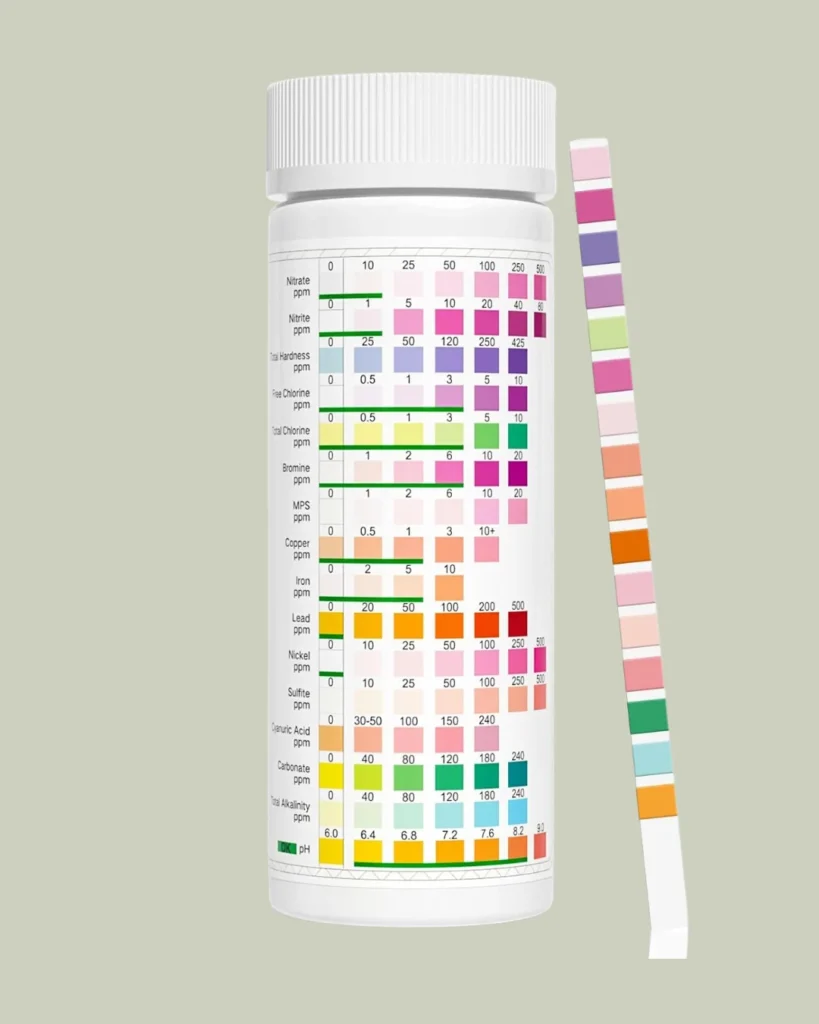
Lead in water is a silent invader. You can’t see, taste, or smell it, but it can be harmful nonetheless. Water testing kits are designed to detect lead and other contaminants in your drinking water.
The Tap Score Advanced Home Water Test Kit offers an analysis of the presence of metals, minerals, bacteria, and organic chemistry related to chlorine or industrial contamination.
You can test for 116 Analytes, including Heavy Metals, Coliform & E. coli Bacteria, Disinfection Byproducts, Nitrates, pH, Hardness, Alkalinity, and other Calculated Parameters.
All you have to do is collect the sample at home, mail it back to them using the pre-paid return shipping labels, and receive detailed lab analysis online.
One of the most trusted DIY lead testing kits for drinking water is TESPERT. You’ll get to test 16 parameters for each water test strip. The set includes 125 strips in total, which equals 2000 water tests with 1 piece of product.
How to Use Home Water Testing Kits:
- Follow the instructions to collect a water sample, usually from your kitchen tap. Some kits require you to let the water run for a few minutes before collecting the sample, while others may require you to collect the first draw of water after the faucet has been unused for several hours.
- Add the reagents provided in the kit to the water sample. The water will change color based on the presence of lead and other contaminants.
- Compare the color change to the provided chart. Some kits also come with digital readers for more precise measurements.
- It’s a good idea to test your water periodically, especially if you live in an older home with old plumbing.
Lead dust is a common issue in homes with deteriorating lead-based paint or contaminated soil. Dust wipe sampling can help you determine if lead dust is a problem in your home.
While I’d highly recommend leaving this one to the professionals, you can grab a DIY kit with individually wrapped wipes for lead dust sampling. These ems wipes meet all ASTM E1792 specifications for sampling materials for lead in surface dust.
How to Use Dust Wipes:
- You’ll need dust wipes, which are often included in home lead test kits, and a resealable plastic bag.
- Wipe a surface, such as a windowsill or floor, with a dust wipe. Make sure to cover a specific area thoroughly.
- Send the wipe to a lab for analysis. Some home kits include prepaid envelopes for this purpose.
- The lab will send you a report indicating the presence and level of lead dust in your home. This method is more accurate than swab tests and is recommended for serious concerns.
If you garden or have children who play outside, testing your soil for lead is essential. Soil testing kits can identify lead contamination in your yard.
These Lead Soil Test strips measure 100, 200, 300, & 400 ppm (mg/L) in less than 10 minutes. Simply collect your soil sample, add the supplied reagent, and dip the test strip.
How to Use Soil Testing Kits:
Follow the kit instructions to collect soil samples from various parts of your yard, especially near old buildings, fences, or areas where your children play.
- Mix the soil with the reagents provided in the kit. The mixture will change color based on the lead content.
- Compare the color to the provided chart. For more accurate results, you might consider sending a sample to a lab.
- If lead is detected, consider covering the soil with grass or mulch and using raised beds for gardening.
How To Interpret Lead Poisoning Test Results At Home
So you’ve done the tests, and now you’re staring at those results, wondering what it all means.
Don’t worry—we’ll break it down so you can understand what different lead levels mean and what steps you should take if lead is detected.
What Different Lead Levels Mean:
Lead in Paint, Dust, and Soil:
- Low Levels (1-10 µg/dL): Even low levels of lead can be harmful, especially to young children. If you find lead at these levels, it’s a signal to start taking action to reduce exposure.
- Moderate Levels (10-20 µg/dL): At this range, the risk increases, and it’s important to implement more rigorous lead abatement measures. This might involve more frequent cleaning and possibly professional intervention.
- High Levels (20+ µg/dL): High levels of lead require immediate attention. Consider bringing in professionals to thoroughly clean and remove lead sources. Avoid areas with high lead levels until they are properly treated.
Lead in Water:
- Below 15 ppb (parts per billion): The EPA’s action level for lead in drinking water is 15 ppb. If your test results show lead below this level, it’s generally considered safe, but it’s wise to continue monitoring.
- Above 15 ppb: If lead levels in your water exceed 15 ppb, it’s time to take action. Use a certified water filter, and consider replacing lead pipes and fixtures. Contact your water supplier to inform them of your findings.
What To Do If Lead Is Found in Your Home.
If Lead is Detected in Paint, Dust, or Soil:
- Regularly clean your home with wet mops and damp cloths to reduce lead dust. Avoid dry dusting or sweeping, which can spread lead particles.
- Use lead-safe practices to seal or remove lead paint. This may involve hiring certified professionals to ensure safe and effective removal.
- Use grass, mulch, or other ground covers to reduce exposure to contaminated soil. Consider raised garden beds with clean soil for growing vegetables.
- Educate your family about lead risks and symptoms. Keep a close eye on children’s behavior and health, and consult a healthcare provider if you notice any concerning symptoms.
If Lead is Detected in Water:
- Install a water filter certified to remove lead (look for NSF/ANSI Standard 53). Replace the filter according to the manufacturer’s instructions to ensure it remains effective.
- Let the water run for a few minutes before using it for drinking or cooking, especially if the faucet has been unused for several hours. This can help flush out any lead that has leached into the water.
- Consider replacing old lead pipes and plumbing fixtures. Contact your water supplier to discuss potential lead sources in your water system.
- Regularly test your water and stay informed about the lead levels. Keep in touch with local water authorities for updates and additional testing options.
How accurate are home lead test kits?
Home lead test kits are pretty handy, but they’re not foolproof. They can give you a quick snapshot, especially surface test kits which are fairly reliable for detecting lead in paint and ceramics.
However, they might miss low levels of lead or not be as precise as lab tests. Think of them as a good first step; if you get a positive result, it’s time to bring in the professionals for a thorough check.
How do you test yourself for lead poisoning?
Testing yourself for lead poisoning isn’t something you can do at home—this one needs a professional touch.
You’ll need to visit your doctor and get a blood test, which is the most accurate way to check for lead levels in your system.
The doctor will take a small sample of your blood and send it to a lab for analysis. If your levels come back high, they’ll guide you on the next steps to reduce exposure and get the lead out of your life.
Can lead be tested at home?
Absolutely, you can test for lead at home! There are kits available for checking surfaces, water, dust, and soil.
Surface test kits are great for painted items and ceramics, while water test kits can help you see if your plumbing is an issue.
Just follow the instructions, and you’ll get a good idea if lead is present. However, for the most accurate results, especially if you find something concerning, professional testing is the way to go.
How do you flush lead out of your body?
If you’ve been exposed to high levels of lead, you’ll need medical intervention. Your doctor might prescribe chelation therapy, which involves taking medication that binds to lead so it can be excreted from your body.
Alongside medical treatment, maintaining a healthy diet rich in calcium, iron, and vitamin C can help reduce lead absorption. Always consult a healthcare professional for the best course of action.
Does lead exposure ever go away?
Lead exposure isn’t something that just goes away on its own. Once lead is in your body, it can linger in your bones and tissues for years, continually releasing small amounts into your bloodstream.
However, with medical treatment like chelation therapy and lifestyle changes to reduce further exposure, you can lower the lead levels in your body over time. The key is to minimize exposure and take proactive steps to protect your health.
What are the symptoms of too much lead?
Too much lead in your body can cause a range of symptoms that are easy to miss at first.
In adults, you might notice headaches, abdominal pain, mood swings, or memory problems. For kids, the symptoms can be more severe, including developmental delays, learning difficulties, irritability, and weight loss. Pets can also be affected, showing signs like vomiting, loss of appetite, and lethargy.
If you suspect lead exposure, it’s crucial to get a blood test and consult a healthcare professional right away.
These were our best tips on how to test for lead exposure at home.
Now that you have a pretty good idea of the potential sources of lead exposure in your home, you can take action!
From old paint chips to contaminated water pipes, lead can lurk where you least expect it, posing serious health risks, especially to children and pregnant women.
Whether through simple DIY kits or professional inspections, don’t just wait until symptoms appear or risks escalate.
It’s also very important to educate yourself and your family about the dangers of lead exposure. Implement preventive measures like regular cleaning, using water filters, and maintaining a lead-safe environment. And, last but not least, stay informed about local resources and guidelines for lead safety.
 Enter To Win An Organic Luxury Mattress From PlushBeds!
Enter To Win An Organic Luxury Mattress From PlushBeds! 